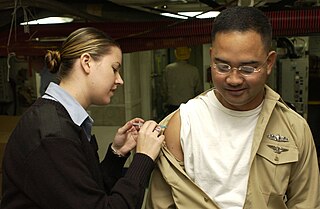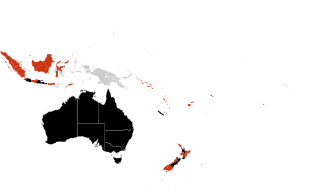Related Research Articles

A pandemic is an epidemic of an infectious disease that has spread across a large region, for instance multiple continents or worldwide, affecting a substantial number of individuals. A widespread endemic disease with a stable number of infected individuals is not a pandemic. Widespread endemic diseases with a stable number of infected individuals such as recurrences of seasonal influenza are generally excluded as they occur simultaneously in large regions of the globe rather than being spread worldwide.

The 1918 flu pandemic, also known as the Great Influenza epidemic or by the common misnomer of the Spanish flu, was an exceptionally deadly global influenza pandemic caused by the H1N1 influenza A virus. The earliest documented case was March 1918 in Kansas, United States, with further cases recorded in France, Germany and the United Kingdom in April. Two years later, nearly a third of the global population, or an estimated 500 million people, had been infected in four successive waves. Estimates of deaths range from 17 million to 50 million, and possibly as high as 100 million, making it one of the deadliest pandemics in history.

Influenza A virus subtype H5N1 (A/H5N1) is a subtype of the influenza A virus which can cause illness in humans and many other species. A bird-adapted strain of H5N1, called HPAI A(H5N1) for highly pathogenic avian influenza virus of type A of subtype H5N1, is the highly pathogenic causative agent of H5N1 flu, commonly known as avian influenza. It is enzootic in many bird populations, especially in Southeast Asia. One strain of HPAI A(H5N1) is spreading globally after first appearing in Asia. It is epizootic and panzootic, killing tens of millions of birds and spurring the culling of hundreds of millions of others to stem its spread. Many references to "bird flu" and H5N1 in the popular media refer to this strain.

Influenza vaccines, also known as flu shots, are vaccines that protect against infection by influenza viruses. New versions of the vaccines are developed twice a year, as the influenza virus rapidly changes. While their effectiveness varies from year to year, most provide modest to high protection against influenza. The United States Centers for Disease Control and Prevention (CDC) estimates that vaccination against influenza reduces sickness, medical visits, hospitalizations, and deaths. Immunized workers who do catch the flu return to work half a day sooner on average. Vaccine effectiveness in those over 65 years old remains uncertain due to a lack of high-quality research.

The Hong Kong flu, also known as the 1968 flu pandemic, was a flu pandemic whose outbreak in 1968 and 1969 killed between one and four million people globally. It is among the deadliest pandemics in history, and was caused by an H3N2 strain of the influenza A virus. The virus was descended from H2N2 through antigenic shift, a genetic process in which genes from multiple subtypes are reassorted to form a new virus.

Roselyne Bachelot-Narquin, generally known as Roselyne Bachelot is a French politician who served as Minister of Culture in the government of Prime Minister Jean Castex (2020–2022) and as Minister of Solidarity and Social Cohesion (2010–2012) in the government of Prime Minister François Fillon. She was a member of the Union for a Popular Movement, which was part of the European People's Party.

Swine influenza is an infection caused by any of several types of swine influenza viruses. Swine influenza virus (SIV) or swine-origin influenza virus (S-OIV) refers to any strain of the influenza family of viruses that is endemic in pigs. As of 2009, identified SIV strains include influenza C and the subtypes of influenza A known as H1N1, H1N2, H2N1, H3N1, H3N2, and H2N3.

Flu season is an annually recurring time period characterized by the prevalence of an outbreak of influenza (flu). The season occurs during the cold half of the year in each hemisphere. It takes approximately two days to show symptoms. Influenza activity can sometimes be predicted and even tracked geographically. While the beginning of major flu activity in each season varies by location, in any specific location these minor epidemics usually take about three weeks to reach its pinnacle, and another three weeks to significantly diminish.

An influenza pandemic is an epidemic of an influenza virus that spreads across a large region and infects a large proportion of the population. There have been six major influenza epidemics in the last 140 years, with the 1918 flu pandemic being the most severe; this is estimated to have been responsible for the deaths of 50–100 million people. The most recent, the 2009 swine flu pandemic, resulted in under 300,000 deaths and is considered relatively mild. These pandemics occur irregularly.

Influenza A virus subtype H3N2 (A/H3N2) is a subtype of viruses that causes influenza (flu). H3N2 viruses can infect birds and mammals. In birds, humans, and pigs, the virus has mutated into many strains. In years in which H3N2 is the predominant strain, there are more hospitalizations.

Equine influenza is the disease caused by strains of influenza A that are enzootic in horse species. Equine influenza occurs globally, previously caused by two main strains of virus: equine-1 (H7N7) and equine-2 (H3N8). The OIE now considers H7N7 strains likely to be extinct since these strains have not been isolated for over 20 years. Predominant international circulating H3N8 strains are Florida sublineage of the American lineage; clade 1 predominates in the Americas and clade 2 in Europe.. The disease has a nearly 100% infection rate in an unvaccinated horse population with no prior exposure to the virus.

Pandemrix is an influenza vaccine for influenza pandemics, such as the 2009 flu pandemic. The vaccine was developed by GlaxoSmithKline (GSK) and patented in September 2006.

This article covers the chronology of the 2009 novel influenza A (H1N1) pandemic. Flag icons denote the first announcements of confirmed cases by the respective nation-states, their first deaths, and relevant sessions and announcements of the World Health Organization (WHO), the European Union , and the U.S. Centers for Disease Control (CDC).

The 2009 flu pandemic in Oceania, part of an epidemic in 2009 of a new strain of influenza A virus subtype H1N1 causing what has been commonly called swine flu, has afflicted at over 22,000 people in Oceania, with 56 confirmed deaths. Almost all of the cases in Oceania have been in Australia, where the majority of cases have resulted from internal community spread of the virus. In addition, the government of New Zealand, where most of the remainder of cases in Oceania have occurred, is on high alert for any people travelling into the country with flu-like symptoms.

The 2009 swine flu pandemic vaccines were influenza vaccines developed to protect against the pandemic H1N1/09 virus. These vaccines either contained inactivated (killed) influenza virus, or weakened live virus that could not cause influenza. The killed virus was injected, while the live virus was given as a nasal spray. Both these types of vaccine were produced by growing the virus in chicken eggs. Around three billion doses were produced, with delivery in November 2009.
The 2009 flu pandemic was a global outbreak of a new strain of influenza A virus subtype H1N1, first identified in April 2009, termed Pandemic H1N1/09 virus by the World Health Organization (WHO) and colloquially called swine flu. The outbreak was first observed in Mexico, and quickly spread globally. On the 11th of June 2009, the WHO declared the outbreak to be a pandemic. The overwhelming majority of patients experience mild symptoms, but some persons are at higher risk of suffering more serious effects; such as those with asthma, diabetes, obesity, heart disease, or those who are pregnant or have a weakened immune system. In the rare severe cases, around 3–5 days after symptoms manifest, the sufferer's condition declines quickly, often to the point respiratory failure. Although Ukraine was not (very) affected at first there was on outbreak of the virus in Western Ukraine in early November 2009 that led to the closing of public buildings and cancellation of meetings for three weeks.
2009 flu pandemic in Taiwan began on May 20, 2009, when a non-citizen who had been living in Taiwan returned from the United States via Hong Kong. By the end of September, more than 90% of influenza A detected in the community were Influenza A (H1N1).

A H5N1 vaccine is an influenza vaccine intended to provide immunization to influenza A virus subtype H5N1.
This is a timeline of influenza, briefly describing major events such as outbreaks, epidemics, pandemics, discoveries and developments of vaccines. In addition to specific year/period-related events, there is the seasonal flu that kills between 250,000 and 500,000 people every year and has claimed between 340 million and 1 billion human lives throughout history.

The 1957–1958 Asian flu pandemic was a global pandemic of influenza A virus subtype H2N2 that originated in Guizhou in Southern China. The number of excess deaths caused by the pandemic is estimated to be 1–4 million around the world, making it one of the deadliest pandemics in history. A decade later, a reassorted viral strain H3N2 further caused the Hong Kong flu pandemic (1968–1969).
References
- ↑ (in French) Plan national de prevention et de lutte "Pandemie grippale" Archived 2009-05-20 at the Wayback Machine . Accessed 2009-08-28. Archived 2009-09-10.
- ↑ (in French) invs.sante.fr Archived 2009-09-10 at the Wayback Machine . Accessed 2009-08-28. Archived 2009-09-10.
- ↑ (in French) GROG website
- ↑ Weekly bulletin of the Regional Flu Observational Groups
- ↑ (in English) Sentinelles Network website Archived 2011-07-21 at the Wayback Machine
- ↑ (in French) Pandemie grippale.gouv.fr Archived 2009-05-09 at the Wayback Machine
- ↑ (in French) France keeps level 5A Archived 2009-08-24 at the Wayback Machine . Accessed 2009-08-28. Archived 2009-09-10.
- ↑ (in French) Nouvel Obs, Une campagne de vaccination obligatoire serait envisagee, 31/05/2009
- ↑ "Commande de vaccins H1N1 : France 3e". 2010-01-08.
- ↑ "Grippe A: deux cas avérés en France". Lexpress.fr. May 2009. Archived from the original on 3 May 2009. Retrieved 2009-05-02.
- ↑ (in French) Le Monde, La France contaminee a son tour par le virus A(H1N1), May 2
- ↑ (in French) 20minutes.fr Archived 2009-07-07 at the Wayback Machine
- ↑ (in French) Le journal du dimanche, "The secret plan against the flu" Archived 2009-06-11 at the Wayback Machine , May 30, 2009
- ↑ (in French) Roselyne Bachelot, Press conference, June 12th Archived 2009-06-17 at the Wayback Machine
- ↑ (in French) tf1.lci.fr Archived 2009-06-21 at the Wayback Machine
- ↑ (in French) Institut de veille sanitaire, BULLETIN EPIDEMIOLOGIQUE GRIPPE A(H1N1) 18 June 2009 @ 6pm
- ↑ (in French) Institut de veille sanitaire, BULLETIN EPIDEMIOLOGIQUE GRIPPE A(H1N1) 26 June 2009
- ↑ (in French) Interview of Roselyne Bachelot, I-Tele, July 3, 2009. Accessed 2009-08-28. Archived 2009-09-10.
- ↑ Les Echos, 1 August 2009
- ↑ Grippe A : le CFCM déconseille de se rendre en pèlerinage à La Mecque
- ↑ (in French) Grippe A: France Télévisions peaufine son scénario-catastrophe, 20 Minutes, 12/08/2009 Archived 2009-08-16 at the Wayback Machine
- ↑ (in French) Article from La Tribune.fr, 18/08/2009
- ↑ (in French) Bulletin grippe AH1N1, 25/08/2009. Accessed 2009-08-28. Archived 2009-09-10.
- ↑ (in French) "Grippe A/H1N1 : un plan de vaccination gratuite et non obligatoire prêt à être activé dès le 28 septembre, si besoin est". Associated Press, 27/08/2009
- ↑ "Grippe A: 6 cas à Castres" (Press release) (in French). Ligue Nationale de Rugby. 2009-08-28. Archived from the original on 2009-08-31. Retrieved 2009-08-29.
- ↑ "TOP 14 Orange : Deux matchs reportes" (Press release) (in French). Ligue Nationale de Rugby. 2009-08-28. Retrieved 2020-09-01.
- ↑ http://www.invs.sante.fr/display/?doc=surveillance/grippe_dossier/points_h1n1/grippe_A_h1n1_061009/index.html [ dead link ]
- ↑ (in French) h1n1 flu : Roselyne Bachelot confirms that the epidemic is starting Archived 2009-09-23 at the Wayback Machine .
- ↑ (in French)Grippe A : le virus devrait toucher 20% des Français by Société française de médecine d'urgence and Samu de France, October 12, 2009
- ↑ (in French) Press release from Institut de veille sanitaire; 24 November 2009
- ↑ (in French) Le Monde/AFP; 26 November 2009
- ↑ (in French) Press release from Institut de veille sanitaire; 27 November 2009
- ↑ (in French) La depeche; 11 December 2009
- ↑ (in French)
- ↑ (in English) French move fuels fears for flu vaccine sales; Reuters, 5 January 2010
- ↑ (in French) Institut national de veille sanitaire, 19 January 2010 Archived 2010-01-26 at the Wayback Machine
- ↑ (in French) Grippe H1N1: recentrage de la vaccination sur les personnes à risque (AFP, 10 February)
- ↑ (in French) INVS bulletin, March 31 Archived 2010-04-08 at the Wayback Machine
- ↑ (in French) Près de 6 millions de Français vaccinés contre la grippe A (H1N1)
- ↑ (in French) H1N1: une facture à 670 millions d'euros pour la vaccination Archived 2010-03-27 at the Wayback Machine
- ↑ (in French) Institut de veille sanitaire. Accessed 2009-08-28. Archived 2009-09-10.